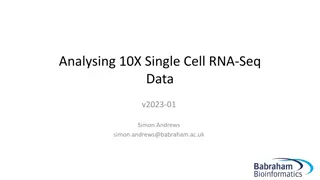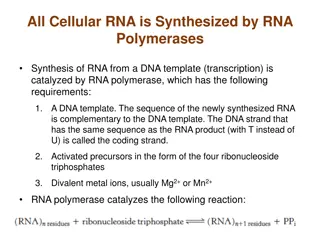Exploring RNA-Seq Read Mapping and Quantitation
Dive into the world of RNA-Seq expression analysis through topics such as read mapping, quantitation, and the challenges faced in short-read mapping. Discover the typical parameters, design pressures, and basic ideas behind suffix tree index construction for efficient handling of large reads and databases in RNA-Seq analysis.
Download Presentation

Please find below an Image/Link to download the presentation.
The content on the website is provided AS IS for your information and personal use only. It may not be sold, licensed, or shared on other websites without obtaining consent from the author. Download presentation by click this link. If you encounter any issues during the download, it is possible that the publisher has removed the file from their server.
E N D
Presentation Transcript
RNA-Seq: a Closer Look at Read Mapping and Quantitation Jeremy Buhler for GEP Alumni Workshop
RNA-Seq Pipeline for Expression Analysis RNA-Seq Read Count per Transcript RNA Source RNA Reads 37251 20653 9827 5121 RNA Abundance per Transcript
Topics for Today Read mapping and RNA quantitation from read counts are two key computational steps in RNA-Seq expression analysis. Mapping: how do we do it fast? Quantitation: how do we get from mapped reads to transcript abundance?
Problem: Short-Read Mapping D Given a genome or transcriptome database D M reads DNA seqs of some length s << |D| M For each read, does it appear in D with at most k differences, and if so, where? s
Typical Parameters Database D has size 107 1010 bases Number of reads M is 106 108 Length s is 75-150 (may vary among reads) # differences k is 0-3 (added, deleted, changed) to account for sequencing errors, polymorphisms
Design Pressures # reads M is huge! minimal time per read Cannot afford to spend O(|D|) time per read as in BLAST need to index database in order to spend less time matching each read Index should be small enough to reside in fast memory, so as to maximize mapping speed
Basic Idea: Suffix Tree Index First, sort all suffixes of database string D to create sorted suffix array A. Second, merge all common prefixes of adjacent strings in A to create a suffix tree T. Leaves of tree correspond to suffixes of D.
Construct a Suffix Array (A) 0 1 2 3 4 5 6 7 8 9 10 acagaccaga$ D = A Position Suffix Suffix 10 $ 10 $ 9 a$ 9 a$ 8 ga$ 0 acagaccaga$ 4 accaga$ 7 aga$ Sort by suffix 7 aga$ 6 caga$ 2 agaccaga$ 6 caga$ 5 ccaga$ 4 accaga$ 3 gaccaga$ 1 cagaccaga$ 5 ccaga$ 8 ga$ 2 agaccaga$ 1 cagaccaga$ 3 gaccaga$ 0 acagaccaga$
Suffix Tree Example 0 1 2 3 4 5 6 7 8 9 10 D = acagaccaga$ T A Suffix a c g a 10 $ 9 a$ $ g a c c a g a 0 aca 4 acc 7 aga$ c $ c a $ c 2 agac 6 caga$ $ c 1 cagac 5 cca 8 ga$ 3 gac 9 0 4 7 2 6 1 5 8 3
Rapid Matching vs Suffix Tree Where is cag? Can find all matches to a read in D using time proportional to read length s. a c g a $ g a c c a g a c $ c a $ c $ c 9 0 4 7 2 6 1 5 8 3
Rapid Matching vs Suffix Tree Where is cag? Can find all matches to a read in D using time proportional to read length s. a c g a $ g a c c a g a c $ c a $ c $ c 9 0 4 7 2 6 1 5 8 3
Rapid Matching vs Suffix Tree Where is cag? Can find all matches to a read in D using time proportional to read length s. a c g a $ g a c c a g a c $ c a $ c $ c 9 0 4 7 2 6 1 5 8 3
Rapid Matching vs Suffix Tree Where is cag? Can find all matches to a read in D using time proportional to read length s. a c g a $ g a c c a g a c $ c a $ c $ c 0 1 2 3 4 5 6 7 8 9 10 D = acagaccaga$ 9 0 4 7 2 6 1 5 8 3
Extension to Inexact Matching To permit matches with k substitutions, try multiple paths, but charge for each mismatch. (Try searching for aca with one mismatch.) To permit matches with k differences, can do dynamic programming or heuristic search to compute edit distance of read against many paths in tree. Descent stops for a read when we hit bottom of tree or find that path requires > k differences.
Spliced read mapping (TopHat) Reads Genome Map unspliced reads Initially Unmapped (IUM) reads S1 S3 S1 GT AG IUM Junction flanking index S2 part 1 S2 part 2 S1 S2 S2 S3 Split IUM into segments
Burrows-Wheeler Transform (BWT) 0 1 2 3 4 5 6 7 8 9 10 D = acagaccaga$ D = acagaccaga$ D = acagaccaga$ Burrows-Wheeler Matrix acagaccaga Suffix Array 10 $ 9 a$acagaccag 10 $ 9 a$ 0 acagaccaga$ 4 accaga$acag 7 aga$acagacc 0 acagaccaga$ 4 accaga$ 7 aga$ 2 agaccaga$ac 6 caga$acagac 2 agaccaga$ 6 caga$ 1 cagaccaga$a 5 ccaga$acaga 8 ga$acagacca 1 cagaccaga$ 5 ccaga$ 8 ga$ 3 gaccaga$aca 3 gaccaga$ BWT: aaaacccg$ga
Virtual Tree: FM-Index Suffix trees need 10-100 bytes memory/base indexed Theorem [Ferragina & Manzini, 2000]: we can build an O(1)-time oracle that, given suffix tree posn corresponding to a string z, returns posn corresponding to one-char extension z.c Hence, we can simulate suffix tree matching without explicitly storing the tree! Space cost: ~1 byte/base
Commonly Used Mapping Software Bowtie [Langmead et al. 2009, 2012] BWA [Li & Durbin 2009, 2010] SOAP2 [Li et al. 2009] All these tools use variants of FM-index approach.
On to Quantitation See the RNA Quantitation from RNA-Seq Data PowerPoint presentation and lecture notes























